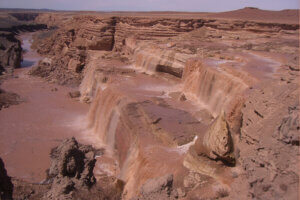When we get a lot of snow melt (Wait, it snows in Arizona?? Heck yeah it does!) or during our dramatic summer monsoon rainstorms, the LC starts pumping all that water and silt and debris across the state, to rendezvous with the mighty Colorado in the Grand Canyon. So when it rains, or when there’s a lot of snow melt, the LC runs muddy. And it flushes all that silt into the Colorado, which then often turns a bit muddy itself.
When the LC isn’t carrying all that mud and debris — when everything but the headwaters and the lowermost reaches are just a dry wash — the water runs turquoise blue near the confluence.
OK, got it? That’s the quick and dirty on the LC. Now let’s talk about its journey across the state. Did you know the Little Colorado creates a 185-foot waterfall in northern Arizona? That’s taller than Niagara Falls! Many people have never heard of Grand Falls, but it’s a stunner. The falls were formed when lava from a nearby crater flowed into the LC and created a lava dam. The river rerouted around the dam and, zowie! Grand Falls was formed where the river rejoins its original course.
When the Little Colorado isn’t running, Grand Falls isn’t running either. It’s a crazy, barren, pock-marked moonscape. Definitely worth seeing.
But when the LC is running? Yowzers! That chocolate milk river pours nearly 200 feet over a wide, dramatic rock face. And that is really worth seeing! Check out this video one of our guides, Kenny, took at Grand Falls in early January, after a big snow melt. Kenny estimated the LC was flowing at about 1,000 cubic feet per second on the day he shot this video.
Like most otherworldly, truly unbelievable, humbling, awe-inspiring things … Grand Falls isn’t always easy to get to — you have to put in some work to see this place. Research it, and check it out if you can — wet or dry.


































